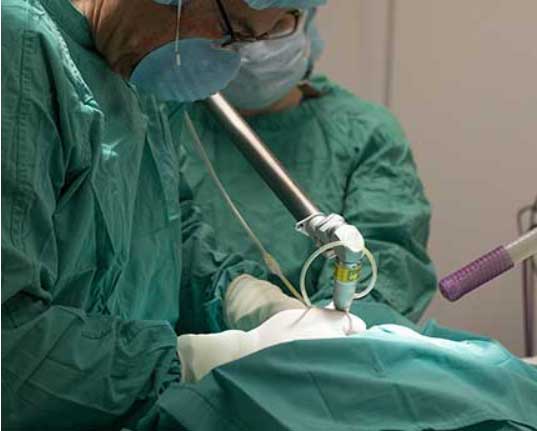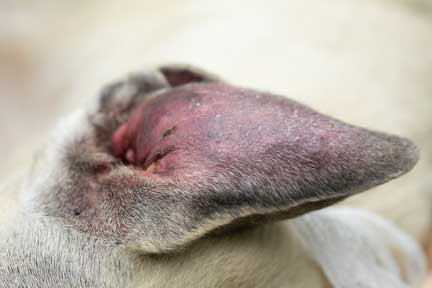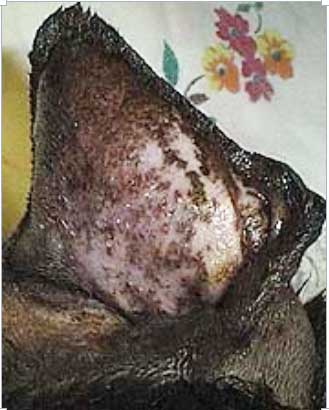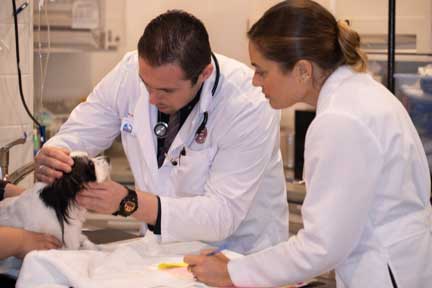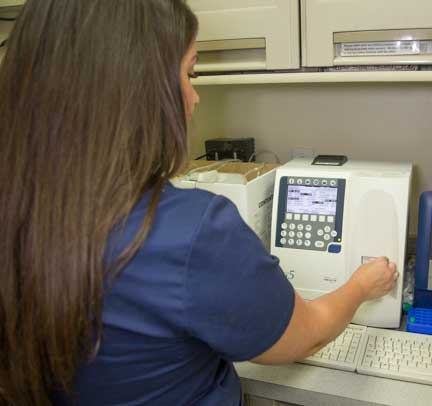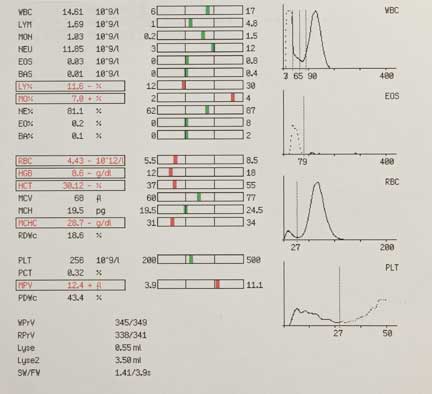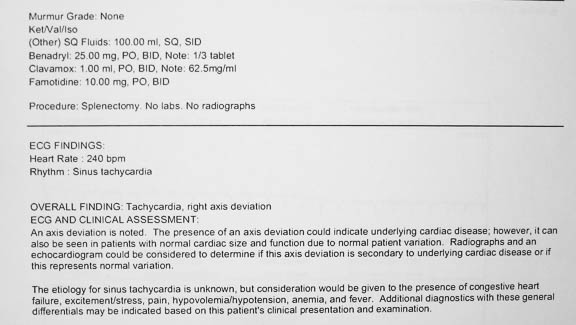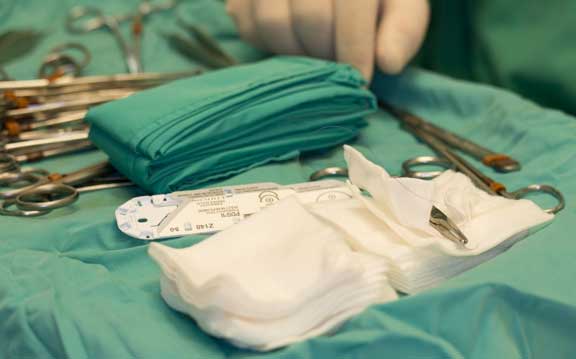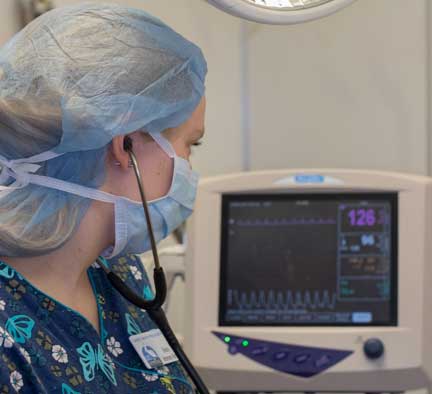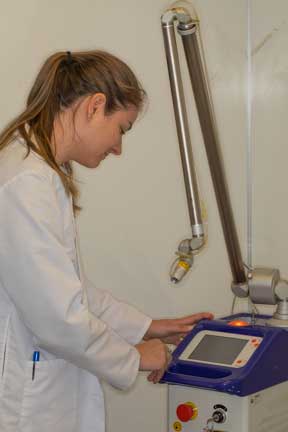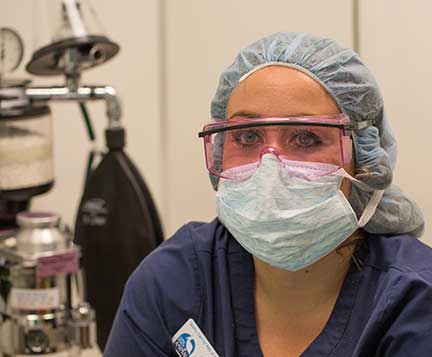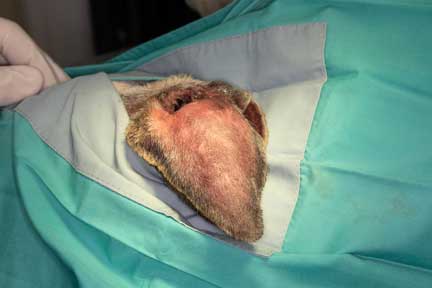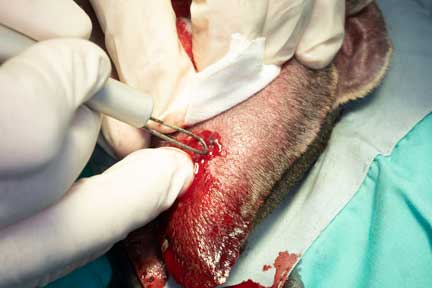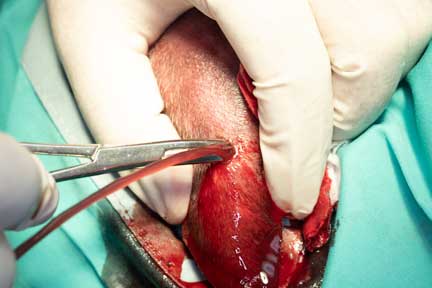On occasion we are presented with a dog or a cat that has a swollen ear flap (pinna). The swelling is due to blood vessels that have ruptured inside the ear flap, between the inside and outside layer of cartilage. This causes the ear to fill up with bloody fluid, and after a period of time the blood in the ear clots and there is a firm swelling.
If left untreated the ear will be painful and will eventually scar down, similar in appearance to a cauliflower ear in a prized fighter that has spent a lifetime in the boxing ring.
This problem is usually corrected surgically. We use the surgical laser because the ear is much less painful during the healing period as opposed to a scalpel blade. The ear is already painful enough with the swelling.
Dr. P has been teaching laser surgery to students and young doctors for decades. Click here to learn more about our surgical laser.
Graphic photos on this page.
Symptoms
The symptoms of an aural hematoma are obvious. The ear flap will be swollen to some degree, sometimes extensively. Almost every pet will either be holding the head to one side or either shaking and pawing at the affected side. It is obviously uncomfortable at the least.
The pinna is swollen and painful in this dog
It happens in cats, but far less commonly than in dogs
Cause
Canines and felines that paw at their ears or shake their heads vigorously, especially those with large ears, can cause an aural hematoma. This pawing and shaking can be due to irritants around the face and ears, or irritants in the external ear canals like infections or foreign bodies (foxtails).
Food allergy is another cause of inflamed ears, causing your pet to shake its head excessively and burst blood vessels.
Medical Treatment
In some cases we can alleviate a small hematoma by removing the fluid and injecting cortisone into the ear and wrapping it to the head. It works 50% of the time at most, and the hematoma in this dog or cat needs to be small.
Your pet will also go home with oral medication to be used for 10 days. This treatment is usually repeated in one week, although some cases are healed after the first week of therapy.
Pets that don’t heal after the second treatment need surgical correction. The initial cause of the hematoma, often times an ear infection or food allergy, will be treated simultaneously.
Surgery Preparation
Even though this is not a major abdominal surgery we treat it as if it was from the surgical and anesthetic point of view. It starts with a thorough pre-anesthetic exam, and the administration of intravenous fluids.
One of our student externs is learning how to perform a pre-anesthetic exam from Dr. Wood
During this exam important organs regarding anesthesia are checked. These organs include the lymph nodes, heart, and lungs.
After the exam a pre-anesthetic blood panel is run. We usually do this in-house so we can get the results within 30 minutes. We don’t want a patient with a painful ear to wait for a blood panel from our main lab to return, which will not be until the next day. We need to get into surgery and alleviate the pain today!
We calibrate our blood machine every day to make sure it is accurate
This is the first page of a two page detailed report. This pet is anemic.
For elderly pets, or those with heart murmurs or heart conditions, we perform an electrocardiogram just prior to surgery.
This one has a potential problem that needs to be addressed
Once our surgeon has reviewed the exam and diagnostic test findings anesthetic is given and he starts prepping. Our anesthesia page is very thorough if you want to learn more.
While our patient is being prepped our surgeon is scrubbing up
When our surgeon is done scrubbing and is capped and masked he prepares his sterile instruments.
Anesthesia is carefully monitored by our nurse with our anesthetic monitor and her stethoscope
Surgical Treatment
We use the carbon dioxide laser for this surgery for its great reduction in bleeding and inflammation. This is important on an ear that is already painful.
The laser is calibrating for this specific surgery. There are special canine and feline settings
When the laser is in use safety goggles need to be worn
The swollen ear is prepped, draped, and ready for surgery
As soon as the laser makes an open for drainage blood appears
The ear is so distended that the blood is under high pressure and streams out immediately
Once all of the fluid is drained out through several openings, and any blood clots removed, the opening in the ear is sutured and it is bandaged. The bandage will stay on for approximately 7 days, your surgeon will let you know. Any sutures placed in the ear will be removed in 10-14 days.
When you pick up your pet you will be given customized home care instructions. Our Home Care of the Surgical Patient page has more details.
Some patients with an aural hematoma are very painful. These dogs and cats can traumatize the painful ear and become an emergency situation. The Long Beach Animal Hospital, staffed with emergency vets, is available until the evenings 7 days per week to help if your pet is having any problems with a painful or traumatized ear.
Think of us as your Long Beach Animal Emergency Center to help when you need us for everything from minor problems to major a major emergency. We serve all of Los Angeles and Orange county with our Animal Emergency Center Long Beach, and are easily accessible to most everyone in southern California via Pacific Coast Hwy or the 405 freeway.
If you have an emergency that can be taken care of by us at the Animal Emergency Hospital Long Beach always call us first (562-434-9966) before coming. This way our veterinarians can advise you on what to do at home and so that our staff and doctor can prepare for your arrival. To learn more please read our Emergency Services page.
Once your pet has a hematoma it is possible for it to recur. You should check your pets ears daily for any recurrence, treat the initiating cause, and clean them frequently.


